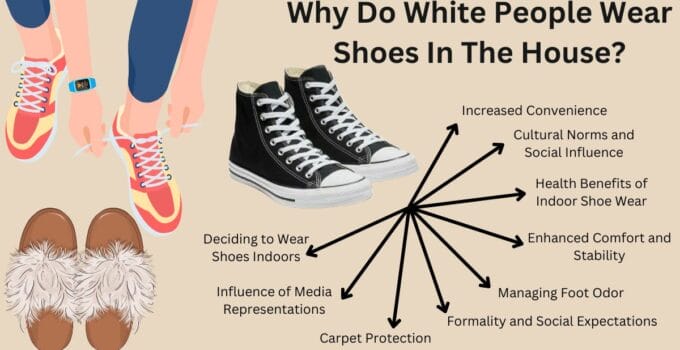Have you ever wondered why some people, especially white Americans, choose to keep their shoes on indoors? It’s a seemingly simple practice that sparks curiosity. Why do white people wear shoes in the house? A question that goes beyond mere footwear preferences.
In this exploration, we unravel the layers behind this everyday choice, delving into cultural roots, practical considerations, and the influence of modern lifestyles. So, kick off your shoes momentarily and join us on this journey to understand the subtle nuances that shape our daily habits.
Cultural and Traditional Aspects
Understanding the Influence of Culture on Indoor Shoe Practices
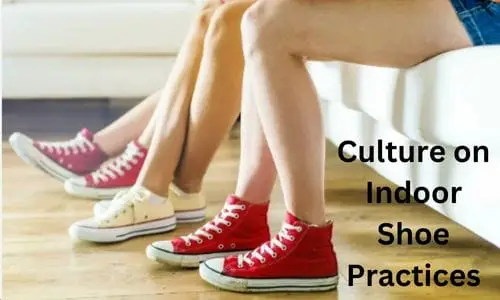
1- European Culture and Indoor Shoe Practices
In cultural norms, European traditions have played a significant role in shaping indoor shoe etiquette. Historically, wearing shoes indoors was the norm in many European households.
This practice was rooted in the desire to maintain cleanliness, especially in regions with colder climates where mud and dirt were common. Over time, this cultural norm found its way into the lifestyle of European descendants, including white Americans.
2- American Habits: Understanding the Norm
Transitioning to the American context, the question of why do white people wear shoes in the house finds its answers in cultural assimilation. The influence of European practices has persisted from colonial times to the present day.
Americans, regardless of their ethnic background, have adopted the habit of wearing shoes indoors. It’s become so ingrained in the culture that, for many, taking shoes off upon entering a home may seem unusual.
3- Global Perspectives: Diverse Cultural Approaches
Beyond the Western world, different cultures have different perspectives on indoor shoe wear. In some Asian cultures like Japan and China, removing shoes before entering a home is customary as a sign of respect and cleanliness. On the contrary, certain Middle Eastern cultures embrace keeping shoes indoors.
Understanding these diverse cultural approaches provides a holistic view, illustrating that choosing to wear shoes indoors is deeply rooted in cultural history. Exploring these global perspectives enriches our understanding of the complexities surrounding this seemingly simple habit.
Practical Reasons for Wearing Shoes Inside
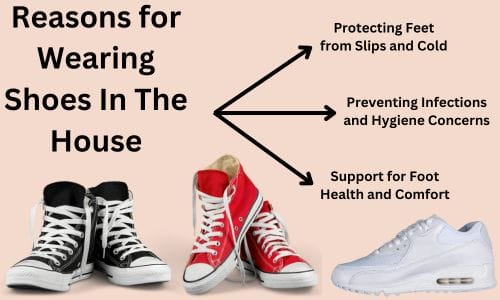
When it comes to wearing shoes indoors, practicality often takes the lead. Let’s step into the realm of reasons that go beyond fashion choices.
1- Protecting Feet from Slips and Cold
Have you ever tiptoed across a freezing kitchen floor or winced at stepping on a Lego block in the living room? Wearing shoes indoors offers a simple solution. It’s not just about keeping your toes warm. It’s a defence mechanism against unexpected obstacles and chilly surfaces. From avoiding accidental slips to shielding against the cold, wearing shoes becomes a practical shield for your feet.
2- Preventing Infections and Hygiene Concerns
Our homes are not always pristine environments. The floor might hide tiny particles, and the occasional spill could create a sticky situation. Shoes act as a barrier, preventing direct contact with potential germs, allergens, or spills that might be lurking beneath. It’s not just about keeping your shoes clean. Maintaining a cleaner living space for your overall well-being is a subtle measure.
3- Support for Foot Health and Comfort
Contrary to the notion that shoes are uncomfortable, some individuals find them to be a source of support. Especially in homes with hard surfaces, shoes can provide cushioning and alleviate the strain on your feet. Whether you’re rushing through daily chores or prefer the added support, wearing shoes indoors is not solely about convenience. It’s about keeping your feet happy and healthy.
In essence, the practicality of wearing shoes indoors extends beyond societal norms. It becomes a personal choice driven by the desire for comfort, protection, and cleanliness in our living spaces. As we explore further, these practical reasons intertwine with cultural contexts, shaping the intricate tapestry of why some choose to keep their shoes on indoors.
Lifestyle Influences
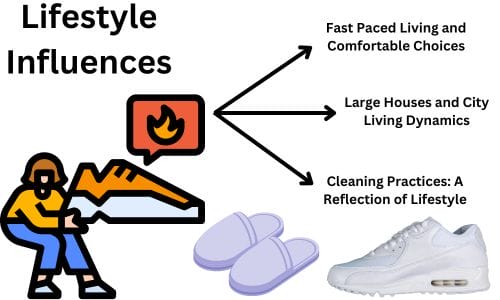
In the realm of indoor shoe choices, lifestyle plays a significant role. Let’s dissect the various influences shaping why some people, particularly white Americans, keep their shoes on inside.
1- Fast-Paced Living and Comfortable Choices
Convenience becomes a top priority in a world that moves at breakneck speed. For many, slipping into and out of shoes throughout the day is an unnecessary interruption. Wearing shoes indoors aligns with a fast-paced lifestyle, allowing individuals to seamlessly transition between indoor and outdoor environments without missing a beat.
Consider the morning rush a quick dash from the bedroom to the kitchen, grabbing breakfast, and out the door. Adding a shoe-removal routine might be impractical for those constantly on the move. In this context, wearing shoes indoors becomes less of a habit and more of a practical choice born out of the need for efficiency.
2- Large Houses and City Living Dynamics
The size and layout of living spaces can significantly impact footwear habits. In more spacious homes, where rooms are interconnected and outdoor spaces easily accessible, the boundary between indoors and outdoors can blur. In such settings, wearing shoes may become a seamless part of navigating the home, especially when outdoor elements are not harsh or muddy.
City living dynamics further contribute to the prevalence of indoor shoe wear. Urban environments often necessitate public transportation and frequent stops, making it more convenient to keep shoes on when moving between various locations. The urban hustle, where every moment counts, can inadvertently shape preferences toward maintaining continuity in footwear choices.
3- Cleaning Practices: A Reflection of Lifestyle
The way one approaches housekeeping also influences indoor shoe habits. For those living in bustling city apartments or expansive homes, the effort involved in maintaining pristine floors may lead to a pragmatic decision: why bother removing shoes when the feet are constantly cleaned? In such scenarios, wearing shoes indoors becomes a matter of practicality, minimizing the need for meticulous floor upkeep.
Moreover, the availability of modern cleaning tools and materials might contribute to a more relaxed attitude towards indoor footwear. High-tech vacuums and efficient floor cleaners make it easier to address the cleanliness concerns associated with wearing shoes indoors, blurring the distinction between what’s clean and what’s not.
In essence, lifestyle influences ranging from the speed of daily life to the size of living spaces and cleaning practices contribute to the prevalence of indoor shoe wear. Understanding these dynamics sheds light on why some individuals, including white Americans, lean towards the convenience of keeping their shoes on inside the house.
Why Do White People Wear Shoes In The House?
Comparative Analysis
Global Indoor Footwear Etiquette: In the realm of indoor footwear practices, diversity reigns supreme. Discovering how different cultures approach the simple act of entering a home is fascinating. Let’s embark on a comparative journey, exploring the varied perspectives on wearing shoes indoors across the globe.
1- Contrasting Habits: Which Countries Discourage Indoor Shoe Wear?
While some cultures embrace keeping shoes on at home, others staunchly discourage it. Take Japan, for instance, where removing shoes before entering a living space is deeply ingrained in their cultural norms. The Japanese view their homes as sacred; stepping inside with outdoor footwear is considered disrespectful.
When you look at Scandinavian countries like Sweden and Norway, it’s remarkable how they approach things. They’re all about that laid-back vibe, especially when wearing shoes indoors. It’s normal there! But here’s the kicker. It’s not just about wearing old shoes inside. Nope, it’s all about keeping those kicks squeaky clean. It’s like this delicate balancing act between being practical and staying clean. Pretty neat.
2- Exploring the Chinese and Japanese Perspectives
With its rich cultural tapestry, China has an exciting take on indoor footwear. Traditionally, shoes are removed upon entering a home, especially in more formal settings. Yet, in modern urban areas, this practice might be more lenient, reflecting the dynamic shift in lifestyle.
In Japan, the custom of removing shoes has deep cultural roots. It symbolizes leaving the dirt and chaos of the outside world behind. This respect for cleanliness extends beyond homes to schools and even some workplaces.
As we navigate these cultural nuances, it becomes evident that the decision to wear or remove shoes indoors is not just about a personal choice but often a reflection of deeply ingrained cultural values.
3- Addressing the Question: Do Chinese and Japanese Wear Footwear at Home?
The answer is multifaceted. The prevailing custom leans towards removing shoes indoors in China and Japan, but exceptions exist. Urbanization, globalization, and evolving lifestyles contribute to a shifting landscape where cultural practices adapt to contemporary realities.
Understanding these global perspectives adds layers to our exploration of why some white Americans, influenced by their cultural roots, wear shoes in the house. It’s a practice influenced by personal comfort and a cultural mosaic that stretches far beyond one’s doorstep.
Specific Focus on White Americans
Historical Context: How European Culture Adapted
Let’s step back to understand how wearing shoes indoors became ingrained in European culture. This tradition carried over to many white Americans. Historically, European households often had dirt floors, and wearing shoes inside provided a practical way to keep one’s feet clean. As civilizations progressed, this habit persisted, eventually influencing the habits of white Americans.
Contemporary Practices: Why Do White Americans Wear Shoes Inside?
Fast forward to the present day, and you’ll find a blend of tradition and evolving lifestyle choices. Like their European ancestors, white Americans may see wearing shoes indoors as convenient and habitual. The norm is deeply rooted, making it a seemingly natural part of everyday life. Additionally, the cultural shift towards more informal living spaces has contributed to the continuation of this practice.
Addressing the Question: Is It Acceptable to Wear Shoes at Home?
The question of whether it’s acceptable to wear shoes indoors remains subjective. While some argue for the comfort and convenience of keeping shoes on, others prioritize cleanliness and comfort without them. White Americans may find themselves at the intersection of tradition and modern living, navigating personal choices amidst evolving societal norms.
The discussion surrounding the acceptability of wearing shoes at home reflects the ongoing dialogue between tradition and the adaptability of cultural practices. As we explore this, it becomes clear that choosing to wear shoes indoors isn’t merely a matter of habit but a reflection of historical, cultural, and individual influences.
Nine Reasons Why Do White People Wear Shoes In The House?
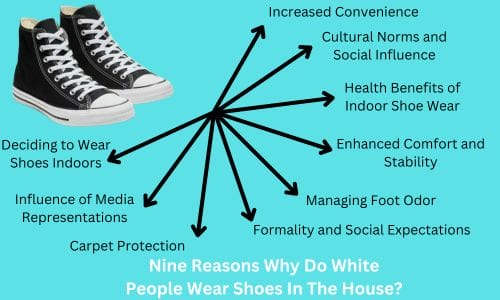
Are you ever curious why some folks in the U.S., especially those with roots tracing back to Europe, have this quirky habit of keeping their shoes on indoors? Let’s dive into the reasons behind this fascinating cultural tradition!
1- Increased Convenience
Wearing shoes indoors can be a matter of sheer convenience. Imagine needing to dash outside or greet unexpected guests. For some, having shoes on simplifies these quick transitions, eliminating the need to search for footwear when time is of the essence.
2- Cultural Norms and Social Influence
Cultural norms play a significant role in shaping our behaviors. In many American households, wearing shoes indoors is the norm. Social influence, often stemming from family traditions and regional customs, can make this habit ingrained from a young age.
3- Health Benefits of Indoor Shoe Wear
Beyond tradition, health considerations also contribute to this practice. Some argue that keeping shoes on provides additional foot support, especially on hard flooring surfaces. This is particularly relevant for individuals with foot conditions or those who spend long hours on their feet.
4- Enhanced Comfort and Stability
Comfort is critical; for some, shoes offer extra cushioning and stability that bare feet or socks might not provide. Especially in homes with minimal carpeting, the desire for added comfort can lead to the preference of keeping shoes on.
5- Managing Foot Odor
Concerns about foot odor can drive the decision to wear shoes indoors. For individuals conscious of the scent their feet may carry, keeping shoes on can be a practical solution, maintaining a sense of freshness in shared living spaces.
6- Formality and Social Expectations
In specific settings, maintaining a level of formality is crucial. Shoes can be seen as part of a polished appearance, aligning with social expectations in formal or semi-formal gatherings. The habit may extend from a desire to present oneself in a certain way, even within the comfort of one’s home.
7- Carpet Protection: A Practical Concern
Preserving the cleanliness and longevity of carpets is another factor. Shoes act as a barrier, preventing dirt, stains, and potential damage from direct contact with the carpet. This consideration becomes especially prominent in households with expensive or light-colored floor coverings.
8- Influence of Media Representations
Media plays a significant role in shaping societal norms. The portrayal of characters on television and in movies often features individuals wearing shoes indoors without a second thought. This constant exposure can subconsciously influence personal habits.
9- Personal Preferences: Deciding to Wear Shoes Indoors
The grand scheme of things comes down to what each person prefers. Sure, folks discover a feeling of ease, practicality, or a touch of the familiar by leaving their shoes on indoors. Acknowledging the reasons behind this practice highlights the diversity of personal choices within the broader cultural terrain.
As we navigate these reasons, it becomes clear that wearing shoes indoors is a nuanced aspect of American culture, shaped by many factors ranging from practicality to individual comfort preferences.
Conclusion
In stepping through the various reasons behind choosing shoes indoors, we have glimpsed into a tapestry woven with cultural threads, lifestyle influences, and personal preferences. From the practicality of protecting against slips to the subtle impacts of media representation, the decision to keep shoes indoors is nuanced.
As we wrap up this exploration, it becomes evident that the answer to why do white people wear shoes in the house is as diverse as the cultures and individuals who make this choice. In understanding these motivations, we gain insight into a seemingly mundane practice and cultivate a broader appreciation for the unique tapestry of habits that shape our daily lives.
Why do some people wear shoes inside their homes?
People wear shoes inside their homes for various reasons. It could be a matter of cultural tradition, where habits passed down over generations become ingrained. Some find practicality in protecting their feet or maintaining cleanliness. Others prefer the comfort and stability that shoes provide. Ultimately, it’s a personal choice influenced by tradition, practicality, and individual comfort.
Specifically, why is the article focused on white Americans?
White Americans are highlighted to provide insight into the historical and contemporary factors shaping their indoor shoe-wearing practices, offering a nuanced perspective on a broader cultural habit.
Are there health benefits associated with wearing shoes indoors?
Some individuals believe that wearing shoes inside provides foot support, protection against slips, and a barrier against cold floors, contributing to overall foot health.
Do other countries have different views on wearing shoes indoors?
Absolutely! Across the globe, views on wearing shoes indoors vary widely. Some cultures have a strict no-shoes-off rule at the door. Take Japan and China, for instance. They’ve embraced the habit of leaving outdoor shoes outside to keep living spaces pristine.
Conversely, it’s more of a mixed bag in places like the United States and parts of Europe. Some households welcome shoes indoors, considering it a matter of personal choice and convenience. So, yes, there are different strokes for different folks when it comes to kicking off (or keeping on) those shoes inside!
Is wearing shoes inside purely a cultural choice, or are there practical reasons as well?
It’s a combination of both. Cultural traditions often influence habits, but practical reasons like foot protection, hygiene, and comfort also play a significant role.
Are there any drawbacks to wearing shoes indoors?
Some argue that wearing shoes inside can contribute to dirt and germs indoors. However, this perception varies among individuals and cultures.
How do media representations influence the choice to wear shoes inside?
Media representations subtly mold our habits, and wearing shoes inside is no exception. When we see characters effortlessly strolling through their homes with shoes on in TV shows and movies, it normalizes the behavior. It reflects the perceived norm, influencing us to adopt similar practices. So, those on-screen depictions affect how we view and treat our indoor footwear etiquette.
What about carpet and floor cleanliness when wearing shoes indoors?
Wearing shoes indoors can impact carpet cleanliness. However, some see it as a trade-off for the convenience and comfort they gain from keeping their shoes on.
Can habits related to wearing shoes indoors change over time?
Absolutely! Like any habit, the preference for wearing shoes indoors is subject to change over time. It’s a personal choice influenced by cultural shifts, lifestyle adjustments, or even a simple change of perspective. People adapt and evolve, and so do their habits. So, whether it’s a shift in comfort, a new cultural influence, or a desire for change, habits related to wearing shoes indoors can transform over time.
How can we engage in open conversations about indoor shoe practices?
Acknowledging the diversity of perspectives and understanding the cultural and personal factors can foster constructive conversations about indoor shoe habits.
